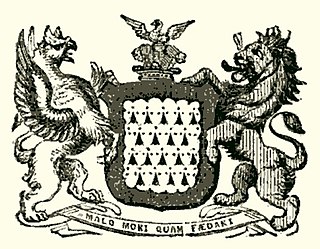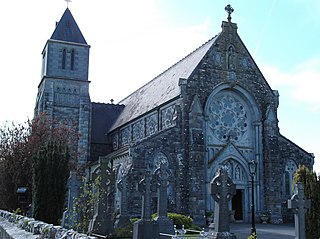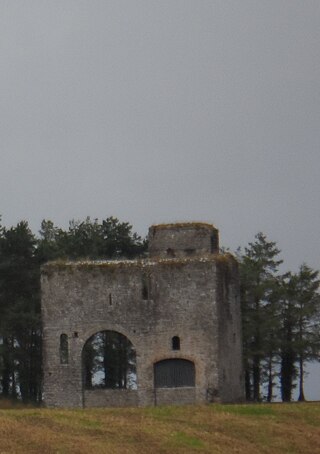The Lord High Chancellor of Ireland was the highest judicial office in Ireland until the establishment of the Irish Free State in 1922. From 1721 to 1801, it was also the highest political office of the Irish Parliament: the Chancellor was Speaker of the Irish House of Lords. The Lord Chancellor was also Lord Keeper of the Great Seal of Ireland. In all three respects, the office mirrored the Lord High Chancellor of Great Britain.

Thomas Jones was Archbishop of Dublin and Lord Chancellor of Ireland. He was also Dean of St. Patrick's Cathedral and Bishop of Meath. He was the patrilineal ancestor of the Viscounts Ranelagh.

John Barnewall, 3rd Baron Trimleston, was an Irish nobleman, judge and politician. He was the eldest son of Christopher Barnewall, 2nd Baron Trimlestown and his wife Elizabeth Plunket, daughter of Sir Thomas Fitz-Christopher Plunket of Rathmore, Lord Chief Justice of the King's Bench in Ireland and his second wife Marian Cruise. He succeeded his father as 3rd Baron about 1513. His father, like most of the Anglo-Irish aristocracy, had supported the claim of the pretender Lambert Simnel to the English throne in 1487. After the failure of Simnel's rebellion, he received a royal pardon.

Thomas Cantock, Quantock or Cantok was an English-born cleric and judge in medieval Ireland, who held the offices of Bishop of Emly and Lord Chancellor of Ireland.
Sir Laurence Merbury was an English-born statesman in Ireland who held the office of Treasurer of Ireland and was also Deputy to the Lord Chancellor of Ireland.

Richard Wogan was an Irish judge and cleric who held the office of Lord Chancellor of Ireland, and also served as a soldier.
William Rokeby was a leading statesman and cleric in early sixteenth-century Ireland, who held the offices of Bishop of Meath, Archbishop of Dublin and Lord Chancellor of Ireland. He is commemorated in the Rokeby Chapels in two Yorkshire churches, St Oswald's Church, Kirk Sandall, and Halifax Minster.
Hugh Inge or Ynge(c. 1460 – 3 August 1528) was an English-born judge and prelate in sixteenth century Ireland who held the offices of Bishop of Meath, Archbishop of Dublin and Lord Chancellor of Ireland.
Robert Wikeford or de Wikeford was an English-born diplomat, lawyer and judge, who became Lord Chancellor of Ireland and Archbishop of Dublin.

Edmund Oldhall was an English-born cleric and judge in fifteenth-century Ireland. He was Bishop of Meath and acting Lord Chancellor of Ireland. He was a brother of the leading Yorkist statesman Sir William Oldhall.
Richard Talbot was an English-born statesman and cleric in fifteenth-century Ireland. He was a younger brother of John Talbot, 1st Earl of Shrewsbury. He held the offices of Archbishop of Dublin and Lord Chancellor of Ireland. He was one of the leading political figures in Ireland for more than thirty years, but his career was marked by controversy and frequent conflicts with other statesmen. In particular, the Talbot brothers' quarrel with the powerful Earl of Ormonde was the main cause of the Butler–Talbot feud, which dominated Irish politics for decades, and seriously weakened the authority of the English Crown in Ireland.
Christopher Bernevall, or Barnewall (1370–1446) was an Irish politician and judge of the fifteenth century, who held the offices of Vice-Treasurer of Ireland and Lord Chief Justice of Ireland. He was deeply involved in the political controversies of his time, and was a leading opponent of the powerful Anglo-Irish magnate James Butler, 4th Earl of Ormond. His elder son Nicholas also held office as Lord Chief Justice, and his younger son Robert was created the first Baron Trimleston.
Patrick Bermingham (c.1460–1532) was an Irish judge and statesman of the Tudor period who held the offices of Lord Chief Justice of Ireland and Chancellor of the Exchequer of Ireland. He was a firm supporter of English rule in Ireland and enjoyed the confidence of Henry VIII, who regarded him as a mainstay of the Irish administration.
Robert le Poer was an Irish judge and Crown official who held the offices of Lord High Treasurer of Ireland and Chief Baron of the Irish Exchequer.
Sir Thomas Fitz-Christopher Plunket (c.1407–1471) was a leading Irish lawyer and judge of the fifteenth century who held office as Lord Chief Justice of Ireland. He was an ancestor of the Duke of Wellington in the female line. His second marriage to the heiress Marian Cruise inspired the ballad The Song of Mary Cruys.
Robert Dyke, Dyck or Dyche was an English-born cleric and judge who held high office in fifteenth-century Ireland. He was appointed to the offices of Archdeacon of Dublin, Chancellor of the Exchequer of Ireland, Lord High Treasurer of Ireland, and Master of the Rolls in Ireland, as well as holding several Church benefices.
Edward Somerton, or Somertoune was an Irish barrister and judge who held the offices of Serjeant-at-law (Ireland) and judge of the Court of King's Bench (Ireland) and the Court of Common Pleas (Ireland). He was born in Ireland, possibly in Waterford, although he lived much of his life in Dublin. By 1426 he was a clerk in the Court of Chancery (Ireland), and was paid 26 shillings for his labours in preparing writs and enrolment of indentures,. In 1427 he is recorded in London studying law at Lincoln's Inn. He returned to Ireland and was again in the Crown service by 1435, when he was ordered to convey lands at Beaulieu, County Louth to Robert Chambre, one of the Barons of the Court of Exchequer (Ireland). He was appointed King's Serjeant for life in 1437; he also acted as counsel for the city of Waterford, a position subsequently held by another future judge, John Gough.
The Great Seal of Ireland was the seal used until 1922 by the Dublin Castle administration to authenticate important state documents in Ireland, in the same manner as the Great Seal of the Realm in England. The Great Seal of Ireland was used from at least the 1220s in the Lordship of Ireland and the ensuing Kingdom of Ireland, and remained in use when the island became part of the United Kingdom of Great Britain and Ireland (1801–1922), just as the Great Seal of Scotland remained in use after the Act of Union 1707. After 1922, the single Great Seal of Ireland was superseded by the separate Great Seal of the Irish Free State and Great Seal of Northern Ireland for the respective jurisdictions created by the partition of Ireland. If the Lord Chancellor was unable for whatever reason to transact business, the Crown might designate another senior judge to act in his place without the Great Seal. In 1375 John Keppock, the Lord Chief Justice of Ireland, was authorised to hear the assizes at Waterford in place of the Chancellor, who was detained on other official business, without the Seal.
The order of precedence in Ireland was fixed by Royal Warrant on 2 January 1897 during Ireland's ties to the United Kingdom of Great Britain and Ireland.
Edward Dantsey or Dauntsey was a fifteenth-century Bishop of Meath, who also held high political office in Ireland, serving as Lord High Treasurer of Ireland and twice as Deputy to the Lord Lieutenant of Ireland. In a curious episode in 1426, he was wrongfully charged with theft, but acquitted.
 St Mary, High Ongar- Chace spent his last years as vicar here.
St Mary, High Ongar- Chace spent his last years as vicar here.



